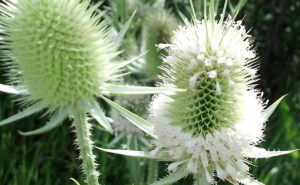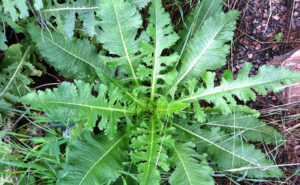Teasel
Colorado has two species of Teasel. Both are Colorado List B noxious weeds. These biennial members of the Teasel family (Dipsacaceae) are originally from Europe and Asia. They have been known in the US since the 1700’s and in Colorado since 1896.
Colorado’s populations of Teasel have exploded in the last 20 years. Found in rights-of-way, empty lots, prairies, savannas, and riparian areas; Teasel displaces native plants that wildlife needs to survive. It also changes ecosystem services and modifies water movement.
Both species have bright green leaves that are opposite and may form a cup surrounding the prickly stem. Plants are 6+ feet tall and have taproots.
Cutleaf teasel (Dipsacus sativus) rosette leaves are distinctly lobed. Common teasel (Dipsacus fullonum, syn. Dipsacus sylvestris) rosette leaves are often crenulated with a pronounced midrib. Common teasel leaf surfaces are prickly and edges are entire and smooth.
Both species flower from June through September and each have small flowers arranged in flowerheads at the end of stems. Cutleaf teasel has predominantly white flowers arranged with bracts that are shorter than the flowerhead. Common teasel has small pink to purple flowers with bracts that are normally longer than the flowerhead.
Both species reproduce by seed with 2000 – 3000 seeds per plant. Most seed falls within 5 feet of the plant and some are spread by birds or animals. Another way Teasel is spread is through ornamental enthusiasts who use the seedheads for decorations or in crafts.
Control options include herbicide, removal, and prevention.





